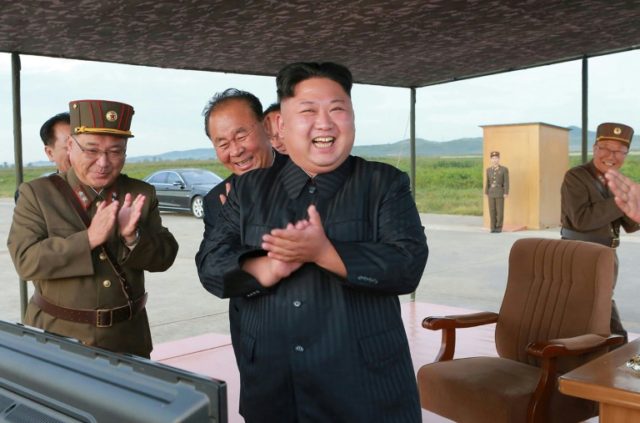North Korea conducted its demolition media event at the Punggye-ri nuclear test site on Thursday, setting off what observers described as a series of explosions that raised a plume of dust and smoke over nearby Mount Mantap.
The event was intended to demonstrate Pyongyang’s commitment to denuclearization, but it only reinforced the skepticism of analysts around the world that dictator Kim Jong-un is more interested in destroying the evidence of past illegal nuclear activities. They also doubted the Punggye-ri site will be fully or permanently decommissioned.
South Korea’s Yonhap News describes the spectacle, which cannot be shown to the world on video until reporters return to the port city of Wonsan on Friday:
The North dynamited the North Portal, also referred to as Tunnel No. 2, at Punggye-ri, a northeastern remote area, at around 11 a.m., they said in a brief pool report delivered by phone.
Two other tunnels were destroyed at 2:17 p.m., followed by the explosion of barracks, observation towers and other facilities on the ground.
The blasts ended at 4:17 p.m., the journalists said without clarifying whether Tunnel No. 1, or the East Portal, was removed as well. Among the four tunnels in the zone, the East Portal was evidently abandoned earlier, according to 38 North, a U.S.-based website.
A Yonhap editorial on Thursday very optimistically described the event as North Korea’s only known nuclear weapons test facility becoming “a thing of the past” as “the country delivered on its promised first step toward denuclearization.”
“The Punggye-ri test site is what the North has used to advance its nuclear capabilities. It should be regarded as a symbolic step of finally submerging the North’s nuclear test site,” Kyungnam University researcher Chang Cheol-un told Yonhap.
Chang’s remarks could be interpreted as damning North Korea with faint praise since the North Koreans are eager for the demolition to be seen as much more than a “symbolic step.” Yonhap’s basically upbeat piece also cites skeptics who said the site has already been rendered largely useless and dangerous by North Korea’s nuclear testing, and it is possible they do not really need to test nuclear warheads anymore after the titanic September blast that collapsed the primary tunnel and alarmed the Chinese.
Voice of America News also casts doubt on the idea that Punggye-ri has been “completely dismantled,” as North Korea claims:
“That renders the test site unusable, but not forever and it’s not like North Korea has a shortage of mountains or people to make new tunnels,” said Jeffrey Lewis, the director of the East Asia Nonproliferation Program at the Middlebury Institute of International Studies in California, during an interview with Vice News.
North Korea conducted all six of its nuclear tests at the Punggye-ri underground site that includes at least two extensive tunnel systems, according the 38 North website that monitors the North’s nuclear activities. Each nuclear test conducted at the site was progressively more powerful, with the first bomb detonated in 2006 producing an estimated 1-2 kiloton yield, much less powerful than the 16-kiloton bomb the United States used on Hiroshima during World War II, and the last test in 2017 producing close to a 250-kiloton yield.
There were reports that the last nuclear test in September of 2017 triggered a tunnel collapse rendering the site unusable, but analysts say there were still two other tunnels that could be used for future tests.
[…] Some analysts have speculated the North would stop short of complete dismantlement and instead seal only the portal entrances to the tunnels, so that workers could later dig out the entrances to make the site operational again, if the government ever wants to resume nuclear tests.
Critics have voiced concern that the closing of the Punggye-ri site does not constitute irreversible denuclearization measures the United States is demanding, and note that in 2007 North Korea disabled its Yongbyong nuclear reactor as part of a deal to end its nuclear program for economic aid, only to restart that facility years later.
North Korea backed out of its initial plan to allow in nuclear weapons experts to observe the closure of the site.
VOA cites an analysis by watchdog group 38 North on Wednesday that dismissed the Punggye-ri event as “grandstanding all around.”
38 North is, however, skeptical of media accounts that claim North Korea’s actions are “tantamount to destruction of evidence and site sanitization.” Pyongyang might be trying to do that, but it probably will not work, since “the forensic evidence will outlast any explosions that may be used to collapse or seal the test tunnels.”
The analysis adds that North Korea probably has a trove of test data that can be used to reconstruct activities at Punggye-ri should inspectors gain access to it, and the data is probably too valuable to delete entirely.
In any event, since Pyongyang is not a signatory to the Nuclear Non-Proliferation or Comprehensive Test Ban treaties, 38 North feels they have little reason to conduct extensive cover-up operations at the test site because there is no reason they would allow inspectors to examine it. If they are hiding anything, it is more likely the fact that other test tunnels remain intact and the site could be reactivated in the future.
News that President Donald Trump canceled his planned June 12 summit with dictator Kim Jong-un reached the Punggye-ri event right after the demolition charges went off, leading to great consternation among the North Korean officials:
Korea Joongang Daily notes that as of press time on Thursday, North Korean state media has issued no official report on the Punggye-ri demolition. China’s Xinhua news cited a claim of “dismantlement” by the North Korean government, which stated that all observation facilities, research institutes, and guard posts will be removed after demolition is completed.

COMMENTS
Please let us know if you're having issues with commenting.